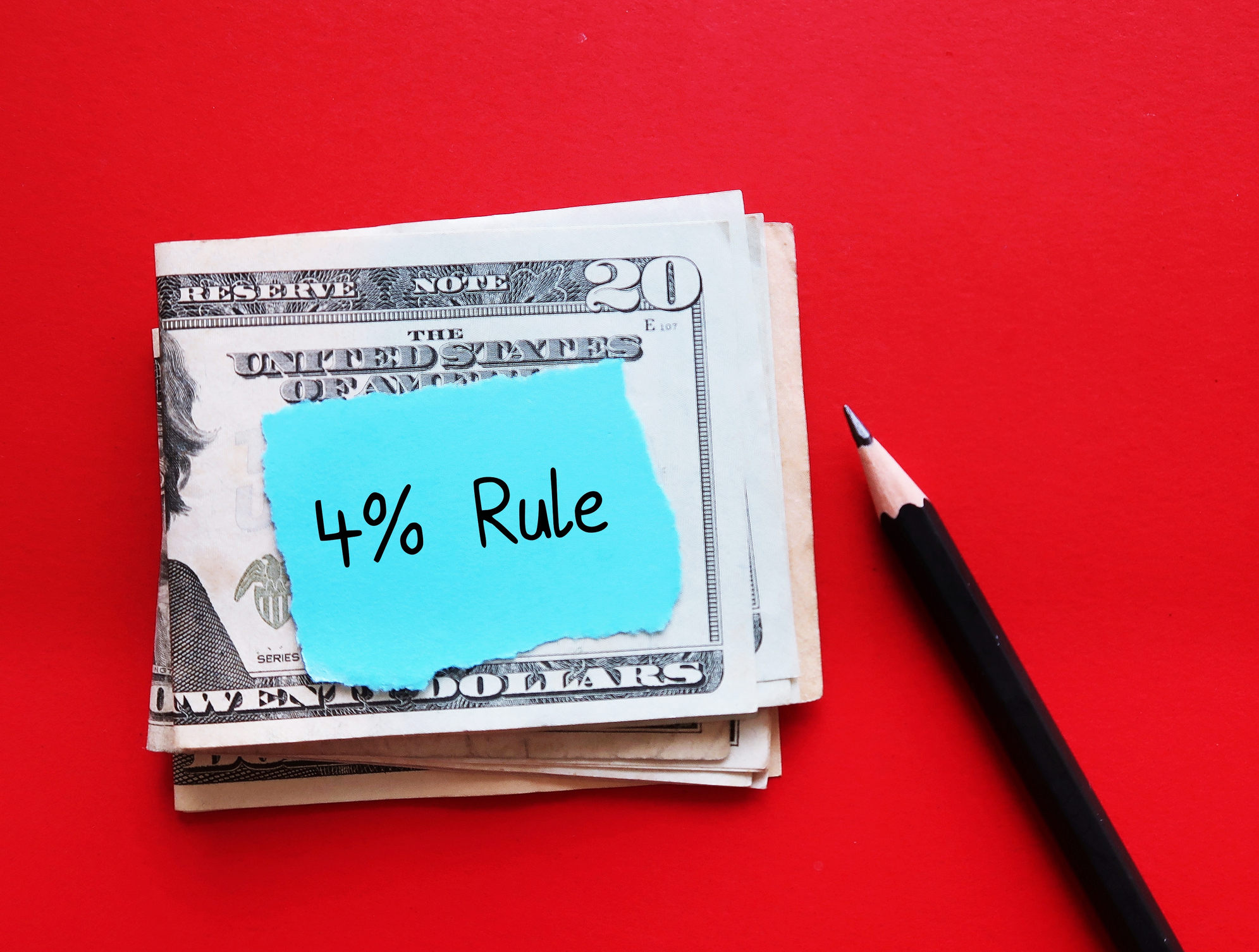The 4% Rule for Retirement Withdrawals Gets an Upgrade
The 4% rule for retirement spending was created over 30 years ago. Things have changed since then. Here's how you can modernize the rule to fit your needs.


When financial adviser William Bengen invented the 4% rule for retirement planning, Beanie Babies were a hot collectible and Forest Gump had just debuted. The rule provides a general guideline for how much to withdraw in retirement safely so you don't outlive your money. But that was in 1994, and it’s fair to ask whether his formula still holds up.
Here's how the 4% rule works. Let’s say you start with a $2.5 million portfolio. In your first year of retirement, you can withdraw 4% of your total balance or $100,000. That sets your baseline. The withdrawal amount increases with the inflation rate each year thereafter. If inflation is 2% in year two, you withdraw $102,000.
In theory, this formula means that “under a worst-case investment scenario, your savings should still last 30 years,” says Karen Birr, manager of retirement consulting at Thrivent in Minneapolis. In practice, however, the formula may require adjusting because Bengen made several assumptions when he devised the rule that don’t always apply today.
From just $107.88 $24.99 for Kiplinger Personal Finance
Become a smarter, better informed investor. Subscribe from just $107.88 $24.99, plus get up to 4 Special Issues

Sign up for Kiplinger’s Free Newsletters
Profit and prosper with the best of expert advice on investing, taxes, retirement, personal finance and more - straight to your e-mail.
Profit and prosper with the best of expert advice - straight to your e-mail.
The 4% rule and markets
First, Bengen assumed that a retirement portfolio would be split approximately 50/50 between stocks and bonds, basing returns on historical market data from 1926 to 1976. “There are some issues with using historic returns,” says Dan Keady, a certified financial planner and senior director of financial planning at TIAA in Charlotte, N.C. For one thing, bond interest rates were higher then, whereas Keady says retirees today could need a higher stock allocation — up to 75% — to generate enough income.
Investing more in stocks in a bear market when the bottom seems nowhere in sight can be tough for retirees to stomach, so another option is to lower the 4% baseline withdrawal rate to “a little over 3%, maybe 3.3%,” says Keady. This means you will need to either accept less income or save for retirement. To generate the same amount of income at 3%, your portfolio would need to be 33% larger.
Longevity challenges the 4% rule
Bengen also assumed that retirement savings should last 30 years to account for longevity risk. Over time, however, life expectancies have risen, and today, savings may need to last 35, even 40 years. This, too, might imply lowering the 4% rate, except some financial advisers say that approach risks too much austerity, especially if markets bounce back. “We commonly see people are so cautious with their spending, they end up with more money three to five years after retiring,” says Sri Reddy, senior vice president for retirement and income at Principal Financial Group in Des Moines, Iowa.
In fact, Bengen himself suggested raising the target rate to 4.5% or even 5% when he observed that many retirees were dying before spending down their savings.
“Having a surplus at the end of life is not a bad thing,” says Birr. “Just make sure it’s something you want.”
However, for some retirees, the "Die With Zero" rule may apply, which encourages them to spend and enjoy their money during their lifetime.
If you’re worried about outliving your savings, Keady suggests transferring part of your portfolio to an annuity for guaranteed lifelong income. An annuity combined with Social Security should deliver enough income to cover essential needs, with the 4% rule applying to your investment portfolio for discretionary spending, like vacations and hobbies. In a bad investing year, discretionary spending can be reduced without affecting the essentials.
Inflation can undermine a 4% approach
When Bengen created the 4% rule, inflation averaged a modest 2% to 3%. While it was recently at 3% as of September, it had hit a more than 40-year high of 9.1% in June 2022. In a high inflationary environment, withdrawing more at the start of retirement to keep pace, particularly when the market is down, can throw retirement planning off track — an effect known as the sequence of returns risk.
Let’s say we have two years of 7% inflation, Keady says. Someone who started withdrawing $100,000 a year would be taking out $114,490 in year three. That’s hard to sustain, as you’ll continue to build off those higher-than-expected withdrawal rates.
One solution is the guardrails, or "Go Live Your Life" rule. Review your portfolio performance and inflation each year, adjusting the withdrawal rate to match your target. If inflation pushes up the baseline withdrawal rate to 6% a year, scale it back.
If a bull market sends your portfolio balance soaring, you may be able to take out less than 3% or 4% with no change in lifestyle. Once you turn 73, required minimum distributions (RMDs) from traditional IRA and 401(k) accounts may force you to withdraw more than you prefer. “The first-year RMD percentage starts at [over 3%] and increases as you get older,” says Birr. Calculating your RMDs can be complex, so consult with a financial adviser if you need help.
Early retirement
If you are among the many people interested in retiring early or the FIRE movement (which stands for financial independence, retire early), the 4% rule may be too aggressive for your needs. Since your retirement will be much longer than average, you must plan early retirement withdrawal strategies for the long haul. And before you leap, consider that a sabbatical may be a smarter move than early retirement.
Spending
Adjusting the withdrawal rate annually also addresses another Bengen assumption: that retirement spending rises linearly, when in fact it fluctuates.
Retirees tend to spend more in the early stages of retirement. “As they get older, spending usually slows down, before possibly picking up again for late-life health care costs,” Reddy says. He prefers that clients allocate more funds initially and adjust their budget later if it appears they might run short. Remember, the 4% rule is only an estimate because everyone’s situation is different, Birr says. “Life events will happen, and you need to be flexible.”
Related Content
Profit and prosper with the best of Kiplinger's advice on investing, taxes, retirement, personal finance and much more. Delivered daily. Enter your email in the box and click Sign Me Up.

David is a financial freelance writer based out of Delaware. He specializes in making investing, insurance and retirement planning understandable. He has been published in Kiplinger, Forbes and U.S. News, and also writes for clients like American Express, LendingTree and Prudential. He is currently Treasurer for the Financial Writers Society.
Before becoming a writer, David was an insurance salesman and registered representative for New York Life. During that time, he passed both the Series 6 and CFP exams. David graduated from McGill University with degrees in Economics and Finance where he was also captain of the varsity tennis team.
- Donna FuscaldoRetirement Writer, Kiplinger.com
- Ellen B. KennedyRetirement Editor, Kiplinger.com
-
 How to Protect Yourself and Others From a Troubled Adult Child
How to Protect Yourself and Others From a Troubled Adult ChildThis case of a violent adult son whose parents are in denial is an example of the extreme risks some parents face if they neglect essential safety precautions.
-
 To Build Client Relationships That Last, Embrace Simplicity
To Build Client Relationships That Last, Embrace SimplicityAs more automation becomes the norm, you can distinguish yourself as a financial professional by using technology wisely and prioritizing personal touches.
-
 Client Demand Is Forcing Advisers to Specialize: How to Deliver
Client Demand Is Forcing Advisers to Specialize: How to DeliverThe complexity of wealthy clients' needs — combined with AI and consumer demand — suggests the future of financial planning belongs to specialized experts.
-
 The 2026 Retirement Catch-Up Curveball: What High Earners Over 50 Need to Know Now
The 2026 Retirement Catch-Up Curveball: What High Earners Over 50 Need to Know NowUnlock the secrets of the 2026 retirement catch-up provisions: A must-read for high earners aged 50 and above.
-
 A 5-Step Plan for Parents of Children With Special Needs, From a Financial Planner
A 5-Step Plan for Parents of Children With Special Needs, From a Financial PlannerGuidance to help ensure your child's needs are supported now and in the future – while protecting your own financial well-being.
-
 I'm 59 With $1.7 Million Saved and Just Lost My Job. Should I Retire at 59½, or Find New Work?
I'm 59 With $1.7 Million Saved and Just Lost My Job. Should I Retire at 59½, or Find New Work?We asked professional wealth planners for advice.
-
 A Wealth Adviser Explains: 4 Times I'd Give the Green Light for a Roth Conversion (and 4 Times I'd Say It's a No-Go)
A Wealth Adviser Explains: 4 Times I'd Give the Green Light for a Roth Conversion (and 4 Times I'd Say It's a No-Go)Roth conversions should never be done on a whim — they're a product of careful timing and long-term tax considerations. So how can you tell whether to go ahead?
-
 A 4-Step Anxiety-Reducing Retirement Road Map, From a Financial Adviser
A 4-Step Anxiety-Reducing Retirement Road Map, From a Financial AdviserThis helpful process covers everything from assessing your current finances and risks to implementing and managing your personalized retirement income plan.
-
 I Drive and Collect Classic Cars: Here’s How I Got in the Game Without Spending a Fortune
I Drive and Collect Classic Cars: Here’s How I Got in the Game Without Spending a FortuneAre classic cars a hobby or an investment strategy — or both? Either way, the vintage car scene is much cooler and more affordable than you think.
-
 The $183,000 RMD Shock: Why Roth Conversions in Your 70s Can Be Risky
The $183,000 RMD Shock: Why Roth Conversions in Your 70s Can Be RiskyConverting retirement funds to a Roth is a smart strategy for many, but the older you are, the less time you have to recover the tax bite from the conversion.
-
 A Financial Pro Breaks Retirement Planning Into 5 Manageable Pieces
A Financial Pro Breaks Retirement Planning Into 5 Manageable PiecesThis retirement plan focuses on five key areas — income generation, tax management, asset withdrawals, planning for big expenses and health care, and legacy.